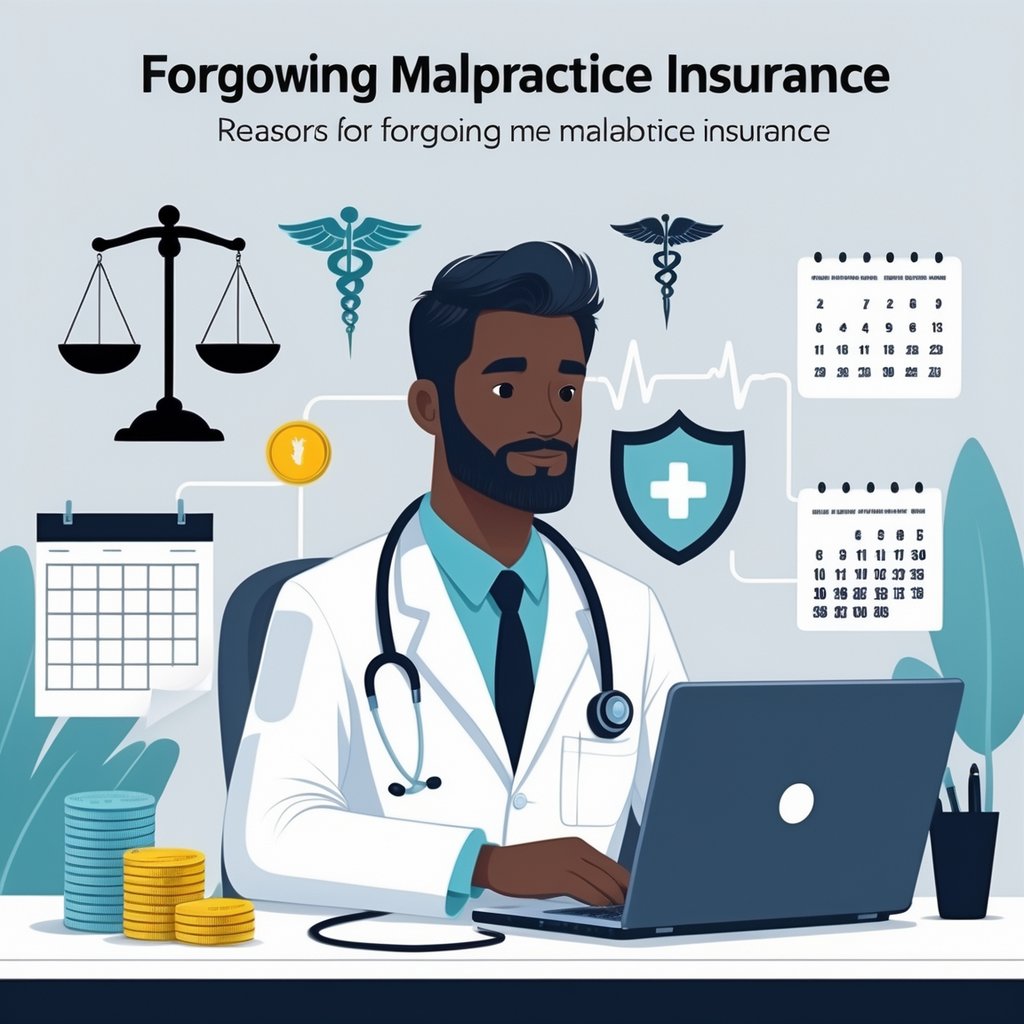A surprising number of doctors practice without malpractice insurance. In medical circles, this is called “going bare.”
Doctors skip malpractice insurance mostly because of high premium costs, a sense that lawsuits are less likely, and a belief that other legal defense options might be more practical.

No federal law requires doctors to carry medical malpractice insurance. Thirty-two states don’t mandate coverage.
This gives you a lot of freedom to decide if insurance fits your practice or budget.
The choice involves a mess of state rules, money, and risk management. Your decision can affect both your career and your personal assets.
Key Takeaways
- Doctors often avoid malpractice insurance because of high costs and the idea it might actually lower their odds of being sued
- Most states don’t legally require malpractice insurance for doctors
- Skipping insurance means you need to plan carefully for legal defense and asset protection
Understanding Malpractice Insurance Requirements

Malpractice insurance requirements depend on your location, employer, and specialty. Eighteen states require minimum levels of coverage.
Federal law doesn’t force doctors to buy insurance.
State and Federal Laws
Medical malpractice insurance isn’t required by federal law. States set their own rules, and 32 states don’t require it at all.
The other 18 states have their own requirements. Some set minimum coverage, others tie insurance to liability reform programs.
Pennsylvania’s MCARE Act is one example. Doctors there must have malpractice insurance with $1 million per claim and $3 million annually.
Colorado’s rules are different. There’s a $250,000 cap on non-economic damages and a $1 million aggregate payout.
Hospital and Employer Mandates
Even in states with no legal requirement, your hospital or employer might insist on coverage. Most doctors carry insurance because hospitals or health plans require it.
Hospitals often make malpractice insurance mandatory for visiting doctors.
Hospitals that employ physicians typically buy policies covering both the hospital and staff. If you’re staff, you might be covered under the group plan.
Many health insurance plans also want doctors to have liability insurance. No coverage? You might lose access to certain patients and income streams.
Specialty-Specific Norms
Insurance requirements aren’t just for doctors. Nurses, midwives, PAs, dentists, and podiatrists often need it too.
High-risk specialties feel more pressure to carry insurance. Surgeons, OB-GYNs, and ER docs usually pay the most and face tougher rules.
State boards and specialty boards can set their own insurance requirements.
Some specialties use group policies or join risk retention groups to handle coverage together.
Common Reasons Doctors Forgo Malpractice Insurance

Doctors skip malpractice insurance for all kinds of reasons. Money, perceived risk, and job structure play big roles.
High Insurance Costs
The main reason is cost. Even after tort reform, some doctors say insurance is just too expensive.
High-risk specialties pay the most:
- Neurosurgery
- OB-GYN
- Orthopedics
- Emergency medicine
Where you practice matters. Some places have fewer insurance carriers, so prices stay high.
Surgical specialties usually pay more than primary care. More lawsuits, bigger claims.
Even with tort reform, some doctors feel the cost isn’t worth it. This can backfire if a lawsuit happens.
Low Perceived Risk of Being Sued
Some doctors think their chances of being sued are low. Maybe their specialty seems safer, or their patients are less likely to sue.
You might think lawyers won’t bother with uninsured doctors. Not really—they can still go after your personal and business assets.
Here’s the reality:
- About one in three doctors get sued during their careers
- Over 65 percent of doctors over 55 have been sued at least once
- Even dismissed cases can cost $22,000 in legal fees
Male doctors get sued more often than female doctors, often due to specialty and demographics.
Good risk management doesn’t erase lawsuit risk. Even great doctors can get sued over outcomes or communication.
Practice Structure or Employment Arrangement
Your job setup matters a lot. Hospital employees might think their employer’s policy is enough, but that’s not always true.
Independent contractors and locum tenens doctors have shifting coverage needs. Assignments change, so does coverage.
Group practice headaches:
- Shared policies sometimes have gaps
- Individual liability can go past group limits
- Changing jobs can mess up coverage
Federal government doctors get coverage through their jobs, so they don’t usually need to buy their own.
Some doctors in “safe” specialties or admin jobs feel less exposed, but liability can still pop up.
Coverage needs depend on how much you see patients, make decisions, or supervise others.
Alternatives to Traditional Malpractice Insurance

Some doctors look for alternatives to standard insurance. Options include self-insurance or joining a group that spreads risk.
Self-Insurance Strategies
Self-insurance means you stash away your own money for possible claims. No insurance company involved. Just a dedicated fund you build up.
What You Need
You’ll need serious assets for this. States that allow self-insurance usually want proof you can cover claims up to a certain amount. Minimums vary by state.
Why Do It?
You keep your money if no one sues you. No insurance company second-guessing your treatment choices.
Risks? Big Ones.
One big claim could wipe you out. No insurer means you hire your own lawyers. This route only works for wealthy doctors in low-risk fields.
Participating in Risk Retention Groups
Risk retention groups let doctors pool resources and share the risk. These are run by the members, not a big company.
How It Works
You join other doctors, usually in the same specialty or area. Everyone chips in. If someone gets sued, the group pays out for legal costs or settlements.
Cost Perks
Risk retention groups can be cheaper since there’s no insurance company profit. Members help set the rules.
Joining Isn’t Automatic
You’ll need a clean malpractice record and board certification. Some groups stick to certain specialties or regions.
Retention Amounts
Usually, you pay the first chunk of any claim. Higher retention means lower yearly contributions.
Potential Risks and Consequences for Doctors

Doctors without malpractice insurance face big financial and professional risks. Malpractice claims can hit your wallet and career hard.
Exposure to Personal Financial Liability
No insurance means you pay all legal costs and damages yourself. Even if you win, legal fees can hit $22,000.
Lose a lawsuit and you could owe hundreds of thousands. Your home, savings, and investments are all on the line.
Legal defense costs might reach $100,000 even if you win. You’ll cover these out of pocket while still running your practice.
Financial risks include:
- Asset seizure
- Wage garnishment
- Bankruptcy
- Loss of retirement savings
Don’t count on lawyers dropping cases just because you’re uninsured. They’ll still chase your assets.
Impact on Hospital Privileges
Most hospitals want doctors to have malpractice insurance before granting privileges. No insurance? You lose hospital access and some patients.
Health insurance plans often require malpractice coverage. Without it, you can’t see certain patients.
Privilege loss means:
- No ER work
- No surgeries
- Fewer referrals
- No teaching hospital gigs
Some states, like Florida, make uninsured doctors post bonds or display signs for patients. These rules add extra hassle and cost.
Effects on Professional Reputation
Operating without malpractice insurance makes you look financially unstable or careless about risk. Colleagues and patients notice, and that can really hurt your standing in the medical community.
Patient compensation becomes uncertain if you don’t have enough resources to cover injuries. This raises ethical concerns about your ability to make things right after a bad outcome.
Reputation impacts include:
- Reduced referral opportunities
- Limited partnership prospects
- Decreased patient confidence
- Professional isolation
You might not get into certain medical networks or group practices, which can leave you feeling cut off. Over time, your career growth and earning potential can take a real hit.
Risk Management Considerations Without Insurance

Doctors who skip malpractice coverage have to get serious about protecting their assets and following all regulations. Practicing without professional liability insurance exposes you to big financial and legal risks.
Asset Protection Strategies
You need to guard your personal and business assets from malpractice claims. Setting up a professional corporation or limited liability company can put some distance between your practice and your own money.
Personal Asset Protection:
- Transfer property ownership to family or trusts
- Keep business and personal bank accounts separate
- Use homestead exemptions if your state allows
- Double-check your retirement account beneficiaries
Professional asset protection means planning ahead. Draw a clear line between your practice and personal investments.
Some states demand specific protections if you practice without malpractice insurance. Florida, for example, makes uninsured doctors post bonds, keep escrow accounts, or get credit lines.
Risk Mitigation Techniques:
- Write up all patient interactions in detail
- Use strict informed consent processes
- Set clear referral rules for tough cases
- Stay current on continuing education
Legal and Regulatory Compliance
Your legal obligations increase a lot if you don’t have insurance. Many hospitals won’t let you work there unless you show proof of coverage.
State medical boards may pile on extra requirements for uninsured doctors. You have to check your state’s rules about medical professional liability.
Compliance Requirements:
| State Type | Requirements |
|---|---|
| No Requirements | 32 states with no minimum coverage |
| Minimum Coverage | 7 states requiring specific limits |
| Reform Participation | 6 states linking coverage to tort reform benefits |
Some places make you tell patients if you don’t have insurance. You might have to put up signs in your office.
Insurance companies and Medicare providers often ask for proof of coverage. Without it, you might lose out on joining certain networks.
You also need to keep great records and meet extra reporting standards. Since you don’t have an insurer’s legal team, your documentation needs to be rock solid.
Trends and Statistics in Malpractice Insurance Coverage

Physician insurance coverage varies a lot by region and specialty. Premiums keep rising, and that makes doctors think twice about carrying malpractice insurance.
Prevalence of Uninsured Physicians
A small but real chunk of doctors goes without malpractice insurance. Depending on the source, somewhere between 3 and 8 percent of practicing physicians have no coverage.
Common reasons for going uninsured include:
- Premiums cost too much
- Planning for retirement
- Narrowing practice scope
- Asset protection strategies
Medical malpractice insurance costs have jumped, hitting solo docs and high-risk specialists especially hard.
Some doctors in states with strong asset protection laws decide to self-insure. Others cut back their practice to lower-risk work, thinking they can get by with less coverage.
COVID-19 changed the equation for some. With more telehealth and shifting practice patterns, a few doctors reevaluated their insurance needs.
Regional Variations
Where you live plays a huge role in malpractice insurance costs and coverage choices. Rates swing wildly by state, so doctors in some places pay a lot more than others.
States with highest premium costs:
- Florida
- New York
- Pennsylvania
- Illinois
- Michigan
States with lowest premium costs:
- Wyoming
- Utah
- Idaho
- North Dakota
- South Dakota
Your location affects not just price but also the legal climate. States with tort reform usually see lower premiums and more doctors getting coverage.
Rural areas have their own headaches. Fewer insurance options and not enough doctors can push some to skip coverage.
Some physicians move to states with better malpractice environments. That reshapes healthcare access and insurance markets in those regions.
Specialty-Based Differences
Your specialty massively affects insurance costs and how you approach coverage. Specialty-specific premiums create clear trends in different fields.
High-risk specialties with expensive premiums:
- Obstetrics and gynecology
- Neurosurgery
- Orthopedic surgery
- Emergency medicine
- Radiology
Lower-risk specialties with affordable premiums:
- Psychiatry
- Family medicine
- Internal medicine
- Pediatrics
- Dermatology
Surgeons pay the most, sometimes over $100,000 a year. That kind of expense pushes some to reconsider coverage, especially as they near retirement.
Your specialty’s risk profile limits your options. Some insurers won’t even touch high-risk fields, so prices can climb even higher.
Emergency medicine brings its own problems. High patient volume and acuity mean more risk, and while premiums can be moderate, many docs get coverage through their employers instead.
Frequently Asked Questions

Doctors have to juggle state laws, money, and practice needs when deciding on malpractice insurance. Practicing without it can mean big financial risks and possible discipline.
What are the potential consequences for a physician practicing without malpractice insurance?
If you work without malpractice insurance, you take on serious financial and professional risks. If someone sues you, you pay for your own legal defense and any settlement or judgment comes out of your pocket.
You could lose your home, savings, and even future wages through garnishment. Courts might slap liens on your property or empty your bank accounts.
Your state medical board could discipline you. That might mean fines, suspension, or even losing your license for good.
These actions go on your record and get reported to the National Practitioner Data Bank. That can haunt your career for years.
Can a doctor legally practice medicine without malpractice insurance in certain states?
Yes, you can legally work without malpractice insurance in many states. No federal law forces doctors to carry medical malpractice insurance.
Each state makes its own rules. Some require minimum coverage, others don’t care.
Even if the state doesn’t require it, most hospitals want proof of insurance before giving you privileges. Without hospital access, your practice options shrink fast.
Some states make you tell patients in writing if you have no coverage. That way, patients know what they’re getting into.
How does the cost of medical malpractice insurance affect a physician’s decision to obtain coverage?
High premiums push some doctors to go without malpractice insurance. Costs can hit tens of thousands a year, especially for risky specialties.
If premiums eat up your income, you might think about dropping coverage. Rural doctors and certain specialists feel this pain the most.
Still, the risk of going uninsured usually outweighs the savings. One lawsuit could wipe you out.
What are the minimum malpractice insurance requirements for physicians in Florida?
Florida doesn’t force you to buy malpractice insurance to practice. You can legally work without it.
But if you skip coverage, you have to prove you can pay claims another way. That might mean posting a bond or showing other financial resources.
Most Florida hospitals still want you to have insurance before giving you privileges. So even though the state allows it, your practice options get limited.
How do malpractice insurance needs differ between physicians and nurse practitioners?
Physicians usually need more coverage than nurse practitioners because of their broader scope and higher lawsuit risk. The stakes are just higher.
Nurse practitioners often work under doctors, which can provide some protection. But if they practice independently, they still need their own policy.
Physicians pay more for premiums than nurse practitioners. That reflects the bigger legal risks and potential payouts in doctor cases.
What legal implications arise for physicians in Florida operating without adequate malpractice insurance?
If you practice in Florida without enough coverage, you risk unlimited personal liability for malpractice claims. Your personal assets could end up on the line if you lose a lawsuit.
Florida doesn’t actually require malpractice insurance, but that doesn’t mean you’re off the hook. The state medical board still has the power to discipline you for unprofessional conduct tied to financial irresponsibility.
Hospitals usually want you to have coverage, too. Most healthcare facilities won’t hand out privileges unless you can prove you have insurance, no matter what state law says.












